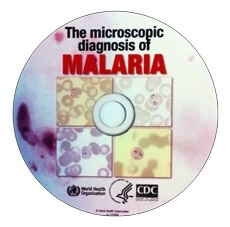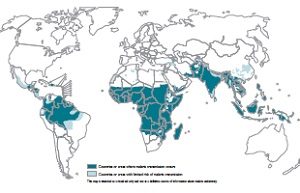The World Malaria Report 2015 summarizes information received from malaria-endemic countries and other sources, and updates the analyses presented in the 2014 report.
The World Malaria Report is WHO’s flagship malaria publication, released each year in December. It assesses global and regional malaria trends, highlights progress towards global targets, and describes opportunities and challenges in controlling and eliminating the disease.
Infection
Malaria is caused by the Plasmodium parasite and is transmitted by female Anopheles mosquitoes which bite between dusk and dawn. There are five different types of parasites that infect humans: P. falciparum, P. vivax, P. ovale, P. malariae, and P. knowlesi. Of these, P. falciparum and P. vivax are the most prevalent, and P. falciparum is the most dangerous, with the highest rates of complications and mortality. This deadly form of malaria is a serious public health concern in most countries in sub-Saharan Africa.
WHO estimates that 214 million cases of malaria occurred worldwide in 2015 (uncertainty range: 149 – 303 million) and about 438 000 people died from the disease (uncertainty range: 236 000 – 635 000), mostly children under five years of age in sub-Saharan Africa.
CD-ROM: The microscopic diagnosis of malaria
This CD-ROM was developed by the United States Centers for Disease Control and Prevention (CDC) with technical contribution from an independent group of experts convened by WHO.
It aims to improve competence in confirming malaria infection with optical microscopy and is intended for microscopists, laboratory technicians and trainers involved in teaching malaria microscopy in endemic countries as well as in malaria-free countries.
It is designed as a training aid for use by an instructor in a class-room setting or for self-instruction, and contains photos of microscopy of human malaria parasites as well as resource documents.
Because of its size, the CD-ROM can be downloaded as a single complete file or in two parts:
The content of the zip file must be extracted before use. Double-click on Start-Course.html to launch the programme.
The content of the two zip files must be extracted before use and the folder “html” (part 2) must be placed inside the folder “exe” (part 1) to reassemble the CD-ROM. Double-click on Start-Course.html to launch the programme.
You can also order the CD-ROM by sending an e-mail to gmpinfo@who.int.
International travellers could be at risk of malaria infection in 97 countries around the world, mostly in Africa, Asia and the Americas. People infected with malaria often experience fever, chills and flu-like illness at first. Left untreated, the disease can lead to severe complications and, in some cases, death. Malaria symptoms appear after a period of seven days or longer. Fever occurring in a traveller within three months of possible exposure is a medical emergency that should be investigated immediately.
If you want to download the World Malaria Report 2015, please click here.
Tip: More up to date information can be found online in the Education Database »medicine & health«.



